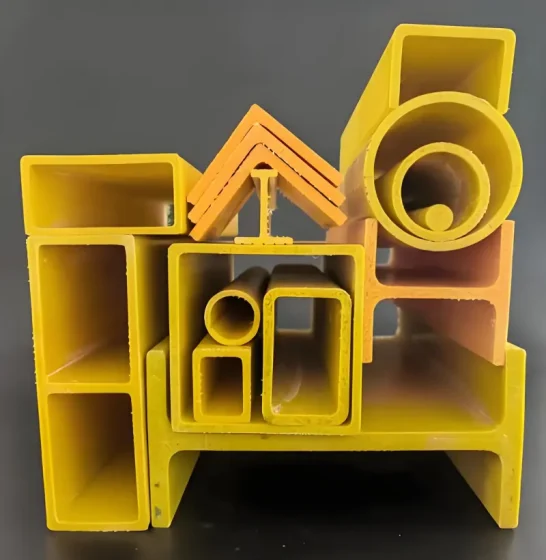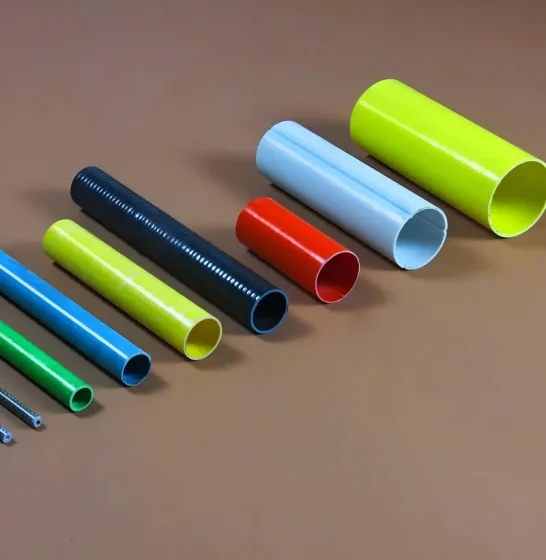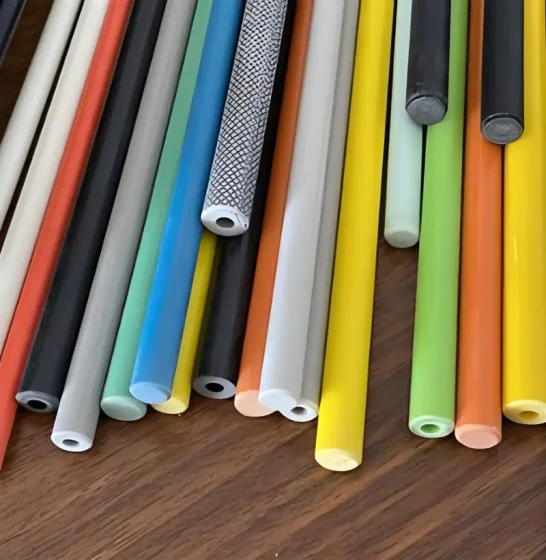(Also known as FRP rectangular tube, pultruded FRP rectangular section, pultruded composite rectangular tube, or pultruded fiberglass rectangular tube)

1. Why Take Corrosion Seriously?
Pultruded fiberglass rectangular tubes (FRP rectangular tubes) are often chosen over steel. They are lightweight, strong, and resist corrosion. Corrosion performance varies significantly based on resin chemistry, fiber content, and surface treatment. Marketing claims such as “lasts 100 years” are meaningless without measured data. Here are three lab results and two field case studies from over 10 years of service. Designers can use these as a reference.
2. Laboratory Immersion Tests: Soaking the samples in chemical baths.
Specimen:
Size: 80 mm × 40 mm × 4 mm
Material: Pultruded rectangular samples
Resin: Vinyl ester
Fiber: E-glass (alkali-free) at 65% by mass
Surface: One layer of 50 g/m² polyester mat
**Method:** GB/T 3857-2017. Full immersion at 23 °C. Conduct 28-day cycles with 5 parallel specimens per group. Researchers report median results.
| Medium | Mass Change Δm (%) | Flexural Strength Retention (%) | Barcol Hardness (change) | Notes |
|---|---|---|---|---|
| 5% H₂SO₄ | +0.08 | 97 | 48 → 46 | Surface dulling; fibers not exposed |
| 10% HCl | +0.11 | 95 | 48 → 45 | Resin-rich edge slight swelling |
| 5% NaOH | −0.19 | 92 | 48 → 43 | Very fine cracks, depth < 20 μm |
| Saturated NaCl | +0.03 | 99 | 48 → 47 | No visible change |
| NaOCl (active chlorine 5%) | +0.14 | 94 | 48 → 44 | Slight surface yellowing |
| 25% NH₃·H₂O | −0.06 | 96 | 48 → 46 | No blistering or delamination |
Interpretation: After 28 days in acid, alkali, or salt, flexural strength stays above 90%. Mass change is less than 0.2%. These results meet the “chemical corrosion resistance” standards from HG/T 20696-2018 for the setup tested.
3. Accelerated Weathering: 1,000 h Salt Fog + UV Cycling
Protocol: ASTM G154-16
UV-B cycle and salt spray coupling:
60 °C UV-B for 4 hours
50 °C condensation for 2 hours.
5% NaCl spray at 35 °C for 2 hours
Accumulate a total of 1,000 hours.
Results:
Appearance: no fiber exposure, no blistering, no cracking.
Flexural strength retention: 98%.
Color change ΔE = 1.5 (imperceptible to the naked eye).
Research shows that 1,000 hours in this combined cycle is like 5 years of coastal outdoor exposure. Performance data show the system keeps more than 90% strength after 25 years.
4. Field Case 1 — Refinery Sewage Service (12 years in operation)
Project: Sewage gallery at a Sinopec refinery, commissioned in 2009. Service conditions: pH fluctuating 2–12, H₂S 20–80 ppm, temperature 25–38 °C, intermittent exposure. Material used: Vinyl ester pultruded rectangular tube, 100 mm × 50 mm × 5 mm; truss span 2.4 m.
Inspection records:
2015 (6 years): flexural strength 410 MPa → 385 MPa (94% retained); Barcol hardness 50 → 46.
2021 (12 years):
Flexural strength: 371 MPa (90% retained)
Hardness: 44
Metallographic exam: Intact resin-fiber interface
Surface powdering: ~15 μm of resin-rich material
Client feedback: The adjacent carbon steel hot-dip galvanized beams needed two replacements recently. In contrast, the FRP gallery has had no replacements so far.
 5. Field Case 2 — Coastal Highway Cable Tray (15 years of operation)
5. Field Case 2 — Coastal Highway Cable Tray (15 years of operation)
Project: Zhoushan Island link, Zhejiang Province, completed in 2008. Environment: Salt deposition rate 2.8 mg/(cm²·day), average relative humidity 78%, annual UV dose 150 kcal/cm². Material: Epoxy pultruded rectangular tubes, 60 mm × 40 mm × 4 mm, in a ladder tray setup; total length is 3.2 km.
Inspection records:
2015 (7 years): flexural strength retention 96%; Barcol hardness 49 → 45.
2023 (15 years): no blistering, no fiber exposure; bolt holes show no cracking. Comparison: The adjacent carbon steel trays lost about 70% of their zinc and showed rust. They will need replacement in about 18 years. In contrast, the FRP tray is still within its 30-year design life.
6. Key Takeaways and Practical Warnings
Resin choice affects resistance. Vinyl ester is great with acids and oxidizers. Epoxy works well in salty and watery settings. Phenolic resins handle high heat but struggle with alkalis.
Surface mat is essential: A 50 g/m² polyester surface mat arrests surface degradation. Omitting it typically reduces strength retention by 10–15%.
Use compatible fasteners. Different metals with FRP can form galvanic couples. This speeds up resin hydrolysis. Use FRP-molded fittings or titanium fasteners where possible.
Avoid fluorinated media unless specified. HF and fluorosilicate media can damage the SiO₂ network in glass fibers. This leads to “glass bloom.” For such environments, use pure plastics or fluorine-lined metals.
Bring measured data into the design process rather than slogans. Corrosion Resistance FRP Pultruded Rectangular Tube systems use a “three-in-one” design. This matches resin, fiber content, and surface treatment. They can handle pH levels from 1 to 13, salt spray, UV light, and H₂S. Also, they last for 25 years with low maintenance.
 FRP/GRP Grating & Profiles Manufacturer – Custom Pultruded Solutions
FRP/GRP Grating & Profiles Manufacturer – Custom Pultruded Solutions
 5. Field Case 2 — Coastal Highway Cable Tray (15 years of operation)
5. Field Case 2 — Coastal Highway Cable Tray (15 years of operation)





Scan the QR Code with WeChat